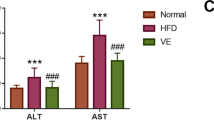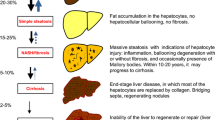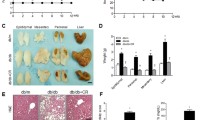Abstract
Chronic fructose consumption and vitamin D deficiency (VDD) diet have been linked to the pandemic of metabolic syndrome (MetS) and nonalcoholic fatty liver disease (NAFLD). The metabolic mechanisms remain unclear. This study is to explore metabolic changes of mice fed with high fructose syrup and VDD diet in the biogenesis of MetS and NAFLD. C57BL/6J mice were treated with four conditions for 28 weeks: control (standard chow and sterile water), fructose drinking (FD, standard chow and 20 g/100 mL fructose in drinking water), VDD (standard chow with VD depleted and sterile water), and FD+VDD. Metabolites in the serum and liver of mice were analyzed by gas chromatography-mass spectrometry combined with trimethylsilyl derivatization. The histological results indicated that one-hit from long-term fructose drinking led to mild MetS, and a combination with VDD diet induced hepatic steatosis, inflammatory lesion, and interstitial fibrosis in mice, showing significant nonalcoholic steatohepatitis features. Metabolomics analysis showed significant changes in amino acids and short-chain organic acids in response to fructose drinking. VDD diet led to significant increase of hepatic fatty acids, which was consistent with the hepatic morphology of fat deposition. This work demonstrated a concert effect of FD and VDD in promoting MetS and NAFLD through changing in vivo metabolism and signaling pathways. And metabolomics analysis could provide early warnings for the biogenesis of MetS and NAFLD. Importantly, vitamin D supplementation in the diet can balance the metabolic disorders caused by excessive fructose intake.








Similar content being viewed by others
References
Al-Dayyat HM, Rayyan YM, Tayyem RF (2018) Non-alcoholic fatty liver disease and associated dietary and lifestyle risk factors. Diabetes Metab Syndr 12:569–575
Alberti KG, Zimmet P, Shaw J (2006) Metabolic syndrome--a new world-wide definition. A consensus statement from the International Diabetes Federation. Diabet Med 23:469–480
Berridge MJ (2017) Vitamin D deficiency and diabetes. Biochem J 474:1321–1332
Black PH (2003) The inflammatory response is an integral part of the stress response: implications for atherosclerosis, insulin resistance, type II diabetes and metabolic syndrome X. Brain Behav Immun 17:350–364
Calvisi DF, Conner EA, Ladu S, Lemmer ER, Factor VM, Thorgeirsson SS (2005) Activation of the canonical Wnt/beta-catenin pathway confers growth advantages in c-Myc/E2F1 transgenic mouse model of liver cancer. J Hepatol 42:842–849
Chagas CE, Borges MC, Martini LA, Rogero MM (2012) Focus on vitamin D, inflammation and type 2 diabetes. Nutrients 4:52–67
Chiu KC, Chu A, Go VLW, Saad MF (2004) Hypovitaminosis D is associated with insulin resistance and β cell dysfunction. Am J Clin Nutr 79:820–825
Dandona P, Aljada A, Chaudhuri A, Mohanty P, Garg R (2005) Metabolic syndrome: a comprehensive perspective based on interactions between obesity, diabetes, and inflammation. Circulation 111:1448–1454
Day CP, James OFW (1998) Steatohepatitis: a tale of two “hits”? Gastroenterology 114:842–845
Doerks T, Copley RR, Schultz J, Ponting CP, Bork P (2002) Systematic identification of novel protein domain families associated with nuclear functions. Genome Res 12:47–56
Dunn WB, Broadhurst DI, Atherton HJ, Goodacre R, Griffin JL (2011) Systems level studies of mammalian metabolomes: the roles of mass spectrometry and nuclear magnetic resonance spectroscopy. Chem Soc Rev 40:387–426
Eliades M, Spyrou E (2015) Vitamin D: a new player in non-alcoholic fatty liver disease? World J Gastroenterol 21:1718–1727
Ford ES (2005) Prevalence of the metabolic syndrome defined by the International Diabetes Federation among adults in the U.S. Diabetes Care 28:2745–2749
Gallagher EJ, LeRoith D, Karnieli E (2011) The metabolic syndrome-from insulin resistance to obesity and diabetes. Med Clin North Am 95:855-+
George J, Tsutsumi M, Tsuchishima M (2017) MMP-13 deletion decreases profibrogenic molecules and attenuates N-nitrosodimethylamine-induced liver injury and fibrosis in mice. J Cell Mol Med 21:3821–3835
Giulietti A, van Etten E, Overbergh L, Stoffels K, Bouillon R, Mathieu C (2007) Monocytes from type 2 diabetic patients have a pro-inflammatory profile. 1,25-dihydroxyvitamin D(3) works as anti-inflammatory. Diabetes Res Clin Pract 77:47–57
Gupta A, Gupta V (2010) Metabolic syndrome: what are the risks for humans? Biosci Trends 4:204–212
Holick MF, Chen TC (2008) Vitamin D deficiency: a worldwide problem with health consequences. Am J Clin Nutr 87:S1080–S1086
Huffman KM, Shah SH, Stevens RD, Bain JR, Muehlbauer M, Slentz CA, Tanner CJ, Kuchibhatla M, Houmard JA, Newgard CB, Kraus WE (2009) Relationships between circulating metabolic intermediates and insulin action in overweight to obese, inactive men and women. Diabetes Care 32:1678–1683
James WP (2008) 22 marabou symposium: the changing faces of vitamin D. Nutr Rev 66:S213–S217
Jang C, Hui S, Lu W, Cowan AJ, Morscher RJ, Lee G, Liu W, Tesz GJ, Birnbaum MJ, Rabinowitz JD (2018) The small intestine converts dietary fructose into glucose and organic acids. Cell Metab 27:351–361
Jensen T, Abdelmalek MF, Sullivan S, Nadeau KJ, Green M, Roncal C, Nakagawa T, Kuwabara M, Sato Y, Kang DH, Tolan DR, Sanchez-Lozada LG, Rosen HR, Lanaspa MA, Diehl AM, Johnson RJ (2018) Fructose and sugar: a major mediator of non-alcoholic fatty liver disease. J Hepatol 68:1063–1075
Khan S, Ali A, Khan S, Bakillah A, Damanhouri G, Khan A, Makki A, AlAnsari I, Banu N (2018) Current therapies in alleviating liver disorders and cancers with a special focus on the potential of vitamin D. Nutr Metab 15:13
Kim D, Touros A, Kim WR (2018) Nonalcoholic fatty liver disease and metabolic syndrome. Clin Liver Dis 22:133-+
Kong M, Zhu L, Bai L, Zhang X, Chen Y, Liu S et al (2014) Vitamin D deficiency promotes nonalcoholic steatohepatitis through impaired enterohepatic circulation in animal model. Am J Physiol Gastrointest Liver Physiol 307:883–893
Krebs M, Krssak M, Bernroider E, Anderwald C, Brehm A, Meyerspeer M, Nowotny P, Roth E, Waldhausl W, Roden M (2002) Mechanism of amino acid-induced skeletal muscle insulin resistance in humans. Diabetes 51:599–605
Lim JS, Mietus-Snyder M, Valente A, Schwarz JM, Lustig RH (2010) The role of fructose in the pathogenesis of NAFLD and the metabolic syndrome. Nat Rev Gastroenterol Hepatol 7:251–264
McCarty MF, Thomas CA (2003) PTH excess may promote weight gain by impeding catecholamine-induced lipolysis-implications for the impact of calcium, vitamin D, and alcohol on body weight. Med Hypotheses 61:535–542
Medina MA (2001) Glutamine and cancer. J Nutr 131:2539S–2542S
Pludowski P, Holick MF, Pilz S, Wagner CL, Hollis BW, Grant WB, Shoenfeld Y, Lerchbaum E, Llewellyn DJ, Kienreich K, Soni M (2013) Vitamin D effects on musculoskeletal health, immunity, autoimmunity, cardiovascular disease, cancer, fertility, pregnancy, dementia and mortality-a review of recent evidence. Autoimmun Rev 12:976–989
Prasad P, Kochhar A (2016) Interplay of vitamin D and metabolic syndrome: a review. Diabetes Metab Syndr 10:105–112
Salehi-Tabar R, Nguyen-Yamamoto L, Tavera-Mendoza LE, Quail T, Dimitrov V, An BS, Glass L, Goltzman D, White JH (2012) Vitamin D receptor as a master regulator of the c-MYC/MXD1 network. Proc Natl Acad Sci U S A 109:18827–18832
Schultz A, Neil D, Aguila BM, Mandarim-de-Lacerda AC (2013) Hepatic adverse effects of fructose consumption independent of overweight/obesity. Int J Mol Sci 14:21873–21886
Sellmann C, Priebs J, Landmann M, Degen C, Engstler AJ, Jin CJ, Gärttner S, Spruss A, Huber O, Bergheim I (2015) Diets rich in fructose, fat or fructose and fat alter intestinal barrier function and lead to the development of nonalcoholic fatty liver disease over time. J Nutr Biochem 26:1183–1192
Styczynski MP, Moxley JF, Tong LV, Walther JL, Jensen KL, Stephanopoulos GN (2007) Systematic identification of conserved metabolites in GC/MS data for metabolomics and biomarker discovery. Anal Chem 79:966–973
Sundborn G, Thornley S, Merriman TR, Lang B, King C, Lanaspa MA, Johnson RJ (2019) Are liquid sugars different from solid sugar in their ability to cause metabolic syndrome? Obesity (Silver Spring) 27:879–887
Younossi Z, Anstee QM, Marietti M, Hardy T, Henry L, Eslam M, George J, Bugianesi E (2018) Global burden of NAFLD and NASH: trends, predictions, risk factors and prevention. Nat Rev Gastroenterol Hepatol 15:11–20
Zhu L, Kong M, Han YP, Bai L, Zhang X, Chen Y, Zheng S, Yuan H, Duan Z (2015) Spontaneous liver fibrosis induced by long term dietary vitamin D deficiency in adult mice is related to chronic inflammation and enhanced apoptosis. Can J Physiol Pharmacol 93:385–394
Acknowledgments
We appreciate Mei Luo in the Public Health and Clinical Center of Chengdu for the biochemical analysis of mice.
Funding
This work was supported by the postdoctoral research and development fund project of Sichuan University (2019SCU12012), the Key Research and Development Project from the Department of Science and Technology of Sichuan Province (grant number 2017SZ0013), and National Science Foundation of China (grant number 31571165 and 31771288).
Author information
Authors and Affiliations
Contributions
YXD, YPH, and WWL were involved in the study conception and manuscript drafting. LZ and ZXH developed the mouse model and implemented the histological analysis. WWL, YLL, CYW, and YJL were involved in the sample collection and analysis, and metabolomics analysis. WWL and LZ interpreted the results and revised the manuscript. All the authors have reviewed and approved the final manuscript.
Corresponding authors
Ethics declarations
Conflict of interest
The authors declare that there are no conflicts of interest.
Additional information
Publisher’s note
Springer Nature remains neutral with regard to jurisdictional claims in published maps and institutional affiliations.
Key points
·Metabolic changes indicate early progress of metabolic syndrome.
·Chronic fructose drinking changes metabolite levels in serum and liver.
·Vitamin D deficiency promotes hepatic fat deposition, inflammation, and fibrosis.
Electronic supplementary material
ESM 1
(DOCX 1226 kb)
Rights and permissions
About this article
Cite this article
Li, W., Zhang, L., Liu, Y. et al. Metabolite profiling of mice under long-term fructose drinking and vitamin D deficiency: increased risks for metabolic syndrome and nonalcoholic fatty liver disease. J Physiol Biochem 76, 587–598 (2020). https://doi.org/10.1007/s13105-020-00764-y
Received:
Accepted:
Published:
Issue Date:
DOI: https://doi.org/10.1007/s13105-020-00764-y




